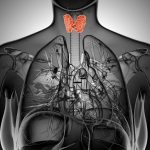The Rising Epidemic of Childhood Obesity: Assessing Altered Body Composition and Managing the Related Chronic Diseases Facing Children and Adolescents Today
Kristi Hughes, ND, and Trish Turpin, ND
It is commonly known today that overweight and obese body types are rising among U.S. adults, but the rising health care consequences in managing the increasing obese population now extend into our youth (CDC, 2004). We now have an epidemic among U.S. children, more commonly discussed in the media, the political arena, and the medical literature (Clinton, 2005; Schwarzenegger, 2005; Daniels et al., 2005). The health-related issues children may experience when they have an altered body composition are not well understood by the general public, which often includes their parents. Furthermore, a child may display a normal height to weight ratio depicted by the body mass index, but may still be at a higher risk for metabolic concerns because of an increased body fat to muscle mass ratio, known as sarcopenic obesity. The type of stored body fat is of greater concern when the elevated deposition is within the visceral adipose tissue as compared with the subcutaneous adipose tissue. The severe consequences of having weight concerns in childhood can be expressed systemically and include elevated inflammatory cytokines, increased risks for cardiovascular complications, the possible development of metabolic syndrome, and the reduction in life span associated with the chronic diseases. The American Medical Association has called for health care providers to increase their awareness of what children are at risk, to screen for and recognize the clinical picture, and to provide education for the associated complications that are connected to this rising epidemic (AMA, 2005).
Financial Implications in the United States
The economic impact of childhood obesity in annual hospital costs alone increased more than threefold from $35 million between 1979 and 1981 to over $127 million between 1997 and 1999 (Wang and Dietz, 2002). This has forced policymakers to make childhood obesity a national priority as we face a predicted financial crisis in our health care system within the next couple decades. The concerns are unique. With both a younger and an older generation, made up of the baby boomers, simultaneously placing similar demands on the medical system for the management of chronic disease, it is predicted that the increased requirement for disability care for such a large number of individuals, along with a decease in the number of healthy employable tax-paying Americans, will result in a compounded issue that will contribute to the exhaustion of the current medical system. (**May insert chart copied from powerpoint slide 2 of childhood population census predications)
Defining Childhood Overweight and Obesity
For the purpose of this review, we have chosen to include a national standardization provided by the American Obesity Association for our reference parameters, which includes the use of the terms overweight and obesity. They are each defined by a body mass index as equal to, or greater than, the 85th percentile and 95th percentile, respectively (CDC, n.d.). The BMI is determined by using the height and weight of the individual and then proceeding with the following calculation: Weight (lbs) ⁄ Height (in) ⁄ Height (in) x 703 or Weight (kg) ⁄ Height (cm) ⁄ Height (cm) x 10,000 (CDC, 2006). For those ages 2 through 20, the BMI charts are gender specific, which is not differentiated for adults.
The prevalence of obese children in the United States ages 6 to 11 has more than doubled from 7% in 1980 to 16% in 2002. For those in the 12-19 age group, the percentage more than tripled, increasing from 5% in 1980 to 16% in 2002 (CDC, n.d.). This suggests that one in every six of your patients’ children is likely obese.
What is creating this trend?
The cause is multifactorial and connected to genetic predispositions, parental overweight or obesity factors, endocrine dysfunctions, sedentary behaviors, and dietary patterns. Skipping meals, eating a high glycemic diet, lacking essential fatty acids and healthy sources of protein, and the overconsumption of nonnutritious calories are some of the largest contributing factors. When we look at what kids are eating these days, Harvard researches have found that 500-1000 calories consumed by kids today come from sugar-sweetened drinks (Salyer, 2004; Larimore). That’s up to half of a teenager’s daily caloric intake! On any given day nearly one third of U.S children aged 4-19 will eat fast food consuming on average 187 calories more each day, which likely packs on about 6 extra pounds of body weight each year (J Pediatr, 2004). Furthermore the choice of high glycemic index foods could be contributing the childhood obesity trend and increased caloric amounts (Decsi et al., 1997). In March of 1999, Pediatrics journal concluded from its study of obese boys that “Voluntary energy intake after [a] high glycemic index food was…81% greater than after [a] low glycemic index food” (Ludwig DS et al., 1999).
Could it be because kids are skipping meals? The International Journal of Vitamin Nutrition Resources examined the difference in the breakfast habits of overweight/obese and normal weight schoolchildren and concluded “it is possible that an inadequate breakfast contributes to the making of poor food choices over the rest of the day and, in the long term, to an increased risk of obesity” (Ortega et al., 1998).
What about activity levels? One in five children ages 8-16 report two or less instances of vigorous exercise per week (CDC, n.d.). Close to 35% of high school students do not engage in the recommended amount of physical activity. (**May insert chart copied from powerpoint slide 6 of 2003 High School Students NOT involved in recommended exercise.) Television watching and computer games certainly pulls kids away from adequate activity. This exposes the average child to more than 20,000 commercials per year. During Saturday morning cartoon shows, 12.5 food commercials are shown per hour reflecting an average of 2500 calories and 106 fat grams per hour (AOA, 2000). According to recent Nielsen Media Research data, the average child or adolescent watches an average of nearly 3 hours of television per day. This figure does not include time spent watching videotapes or playing video games. A 1999 study found that children spend an average of 6 hours 32 minutes per day with various media combined (AAP, 2001). The adjusted odds of incidence of obesity in children in the United Sates between 1986 and 1990 were 8.3 times greater for youth watching more than 5 hours of television per day compared with those watching 0-2 hours.
Is there a hereditary component? In a study published by the New England Journal of Medicine, it was found that parental obesity more than doubles the risk of adult obesity among both obese and nonobese children under 10 years of age. This same study further concluded among those who were obese during childhood, the chance of obesity in adulthood ranged from 8% for 1- to 2-year-olds without obese parents to 79% for 10- to 14-year-olds with at least one obese parent (Whitaker et al., 1997).
So what is the “downstream” effect of childhood obesity?
Almost half of severely obese children have metabolic syndrome (Weiss et al., 2004) defined as including three of the five following diagnostic indicators: a BMI greater than the 95th percentile, a fasting glucose greater than 110 mg/dl, systolic blood pressure exceeding the 90th percentile, fasting triglycerides above 100 mg/dl, or an HDL less than 50 mg/dL (de Ferranti et al., 2004). Of overweight adolescents, 89% had at least one abnormality of the metallic syndrome and 56% had two abnormalities. Approximately 60% of overweight children and adolescents have at least one additional risk factor for cardiovascular disease, such as elevated blood pressure, hyperlipidemia, or hyperinsulinemia. More than 25% have two or more risk factors (Weiss et al., 2004).
Assessing Body Composition and Associated Labs
There are now new options for the pediatric market to assess children’s body composition using bioelectrical impedance analysis (BIA) technology and published algorithms specific to children. BIA is a more accurate way to analyze body fat, body water, and lean muscle mass, versus the BMI, which is strictly based on height and weight. A decrease in muscle mass and an increase in body fat may not alter the BMI, but this altered body composition would be suggestive of metabolic syndrome. ImpediMed introduced a new FDA-approved BIA device into the U.S. clinical field in 2005, increasing health care practitioners’ ability to provide serial tracking for each client after establishing a baseline body composition assessment (ImpediMed.com, n.d.).
Another important characteristic of metabolic syndrome is the location where the adipose tissue accumulates. A simple waist circumference can easily identify children with metabolic syndrome. Waist to hip ratios for boys and prepubescent females should be less than 1.0, and postpubescent females no greater than 0.8 (Lehrman, n.d.). The most comprehensive assessment for childhood obesity includes a routine monitoring of waist circumference, a waist to hip ratio, a body mass index, and a bioelectrical impedance analysis, all of which are noninvasive and extremely cost efficient to the patient.
If an altered body composition is determined, fasting glucose and insulin levels followed by a 2-hour, 75-mg glucose challenge measurement should be taken to determine the degree of insulin resistance. Optimal laboratory measurements should include a fasting glucose between 80 and 90 and a 2-hour postprandial glucose between 80 and 120, a fasting insulin below 15, and a 2-hour postprandial insulin less than 50. Measuring lipid levels is also important for assessing altered body composition in children. A ratio of triglyceride levels to HDL levels greater than 2 is a concern for insulin resistance in children, indicative of the need to rule out the metabolic syndrome. High-sensitivity C-reactive protein is strongly related to adiposity in both girls and boys, which appears to be preceded by insulin resistance (Salmenniemi et al., 2004).
Case Management Suggestions
To improve body composition, the most important changes in the diet are eating small frequent meals, averaging four to five per day. It is important to avoid skipping meals, especially breakfast, choosing low glycemic index foods that will prevent hyperinsulinemic and hyperglycemic response patterns, and consuming adequate protein throughout the day. Eating small amounts every 3 hours stabilizes blood sugar levels, so the body never feels hungry and stressed. Prolonged fasting or long periods between meals can lead to consuming more at the next meal and storing excess energy in adipocytes. Each “mini meal” should try to include a source of protein to improve the balance of the meal on the glycemic load to the blood. Soy is one of the best proteins shown to reduce insulin resistance and improve lipid dysfunctions. Green tea and cinnamon have been shown to reduce insulin resistance, as have the micronutrients magnesium, vanadium, and chromium. Ensuring a good source of omega-3 oils is another dietary staple to enhance cell insulin receptivity (Lukaczar, n.d.). The essential fatty acids also help reduce inflammatory markers, improve blood lipid levels, and reduce hypertension. If given to mothers in the third trimester of pregnancy and baby is supplemented either directly or through the breast milk during the first year of life, EFAs contribute to increased visual acuity, increased cognitive function (Horwood and Fergusson, 1998), reduced asthmatic risks, and improved body composition in the first years of life. Breastfeeding has been found to have a positive influence on the prevention of childhood body composition concerns through multiple mechanisms and the reduction of metabolic syndrome (Stuebe et al., 2005). JAMA published an article in 2001 in which the authors state, “Our findings indicate that infants who were predominantly fed breast milk in the first 6 months of life had a lower prevalence of overweight 9 to 14 years later. Compared with infants predominantly fed infant formula, the estimated relative reduction in risk was approximately 22%. In addition, the apparent protective effects were larger with increasing duration of breastfeeding” (Gillman MW et al., 2001). (**May insert chart copied from powerpoint slide 7 and 8)
Conclusion
Although the epidemic of childhood obesity is apparent in observing children today in the United States, a call to action must occur to increase the naturopathic practitioner’s awareness of the associated health consequences facing these children as they move into adulthood. The generation of overweight children are at an increased risk for becoming overweight adults, with metabolic consequences that will increase their risk factors for both type 2 diabetes and cardiovascular disease. The children facing these health risks today have been reported to be the first generation in a decade that is not predicted to live longer than their parents. The management starts with increased practitioner awareness, early assessment and detection, adequate laboratory analysis, routine monitoring, a balance in both macronutrients and the appropriate micronutrients, along with a steady modification in the lifestyle to achieve a balance of exercise and dietary influences. Lifestyle modification programs are available for training interdisciplinary physicians in the specific strategies to use the bioelectrical impedance analysis as a part of a program aimed to improve the body composition, while creating an individualized diet that is calorically specific to that individual’s needs (FirstLineTherapy.com). Balancing the inflammatory dietary influences and focusing on the types of fruits, vegetables, and grains to include in the diet will reduce the incidence of the blood sugar complications. Adding a healthy protein drink either with or for a breakfast, along with supplementing EPA/DHA, is often one of the first steps toward reducing an altered body composition and addressing the associated chronic diseases.
References
American Academy of Pediatrics (AAP): Children, adolescents, and television, Pediatrics 107(2):423-6, 2001.
American Medical Association (AMA): AMA issues new directives to help fight childhood obesity, Press Release June 22, 2005, http://www.ama-assn.org/ama/pub/category/15257.html (accessed July 2006).
American Obesity Association (AOA): Objectives for Achieving and Maintaining a Healthy population, Jan 25, 2000, http://www.obesity.org/subs/advocacy/HealthyWeight_2010.shtml (accessed July 2006).
Centers for Disease Control and Prevention (CDC): http://www.cdc.gov/growthcharts
Centers for Disease Control and Prevention (CDC): National Center for Health Statistics, Page 27 of the report http://www.cdc.gov/nchs/data/hus/hus04trend.pdf#069
Centers for Disease Control and Prevention (CDC): National Center for Health Statistics ftp://ftp.cdc.gov/pub/Health_Statistics/NCHS/Publications/Health_US/hus04figures/Fig14.xls (accessed July 2006).
Centers for Disease Control and Prevention (CDC): Overweight and Obesity: Obesity Trends: U.S. Obesity Trends 1985–2004, http://www.cdc.gov/nccdphp/dnpa/obesity/trend/maps/index.htm (accessed July 2006).
Clinton B: We must act now, Parade Magazine Sept 25, 2005, http://www.parade.com/articles/editions/2005/edition_09-25-2005/featured_0 (accessed July 2006).
Daniels SR et al: Overweight in children and adolescents. Pathophysiology, consequences, prevention, and treatment, Circulation 111:1999-2012, 2005.
de Ferranti SD et al: Prevalence of the metabolic syndrome in American adolescents: findings from the Third National Health and Nutrition Examination Survey, Circulation 110:2494-7, 2004.
Decsi T et al: Reduced plasma concentrations of alpha-tocopherol and beta-carotene in obese boys, J Pediatr 130(4):653-5, 1997.
FirstLine Therapy: www.FirstLineTherapy.com
Gillman MW et al: Risk of overweight among adolescents who were breastfed as infants, JAMA 285(19):2461-7, 2001.
Horwood LJ, Fergusson DM: Breastfeeding and later cognitive and academic outcomes, Pediatrics 101(1):E9, 1998.
ImpediMed, Inc. Contact person in US: Jack Butler, Vice President, North American Business Development: 585.248.2554; www.impedimed.com; [email protected].
J Pediatr, Jan 2004.
Larimore W: SuperSized Kids: How to Rescue Your Child from the Obesity Threat, New York, 2005, Warner Books.
Lehrman R: Applied Nutrition Science Report, Body Composition (downloadable in a pdf from www.Metagenics.com, ANSR research articles, and the Functional Medicine Research Center in Gig Harbor Washington).
Ludwig DS et al: High glycemic index foods, overeating, and obesity, Pediatrics 103(3):E26, 1999.
Lukaczar D: Applied Nutrition Science Report, Nutrients for Insulin Resistance (downloadable in a pdf from www.Metagenics.com, ANSR research articles).
Ortega RM et al: Difference in the breakfast habits of overweight/obese and normal weight schoolchildren, Int J Vitam Nutr Res 68(2):125-32, 1998.
Salmenniemi U et al: Multiple abnormalities in glucose and energy metabolism and coordinated changes in levels of adiponectin, cytokines, and adhesion molecules in subjects with metabolic syndrome, Circulation 110:3842-8, 2004.
Salyer S: Kids and obesity: stopping the epidemic, HeraldNet.com, April 18, 2004, http://www.heraldnet.com/stories/04/4/18/18450358.cfm (accessed July 2006).
Schwarzenegger.com: Governor Schwarzenegger signs landmark legislation to combat childhood obesity, Press Release Sept 15, 2005, http://www.schwarzenegger.com/news.asp?id=2094 (accessed July 2006).
Stuebe AM et al: Duration of lactation and incidence of type 2 diabetes, JAMA 294(20):2601-10, 2005.
Wang G, Dietz WH: The economic burden of obesity in youth aged 6 to 17 years: 1979-1999, Pediatrics 109(5):E81-1.
Weiss R et al: Obesity and the metabolic syndrome in children and adolescents, N Engl J Med 350:2362-74, 2004.
Whitaker RC et al: Predicting obesity in young adulthood from childhood and parental obesity, N Engl J Med 337(13):869-73, 1997.
Dr. Kristi Hughes is a graduate of the National College of Naturopathic Medicine in Portland, Oregon. In 1997 she founded the Center of Natural Healing Arts, which has clinic sites in Minnesota providing various modalities of natural health care in an integrated clinic environment. In addition to her extensive clinical practice and lecturing experience, Dr. Hughes has served as secretary of the Minnesota Association of Naturopathic Physicians.
Trish Turpin, ND, is the newest member of the Healing Arts Center. She received her degree in naturopathic medicine from The Canadian College of Naturopathic Medicine in Toronto, Canada. Prior to this she worked as a nutritionist, receiving her diploma from the Canadian College of Holistic Nutrition. She has been certified as a personal trainer through the National Strength and Conditioning Association and worked with groups and individuals designing various exercise programs. She received her bachelors in kinesiology from McMaster University and worked as a kinesiologist implementing physical rehabilitation programs for various facilities. Dr. Turpin’s practice is focused on educating clients on the power of living a healthy lifestyle and offering natural health care solutions to today’s complicated medical conditions.










